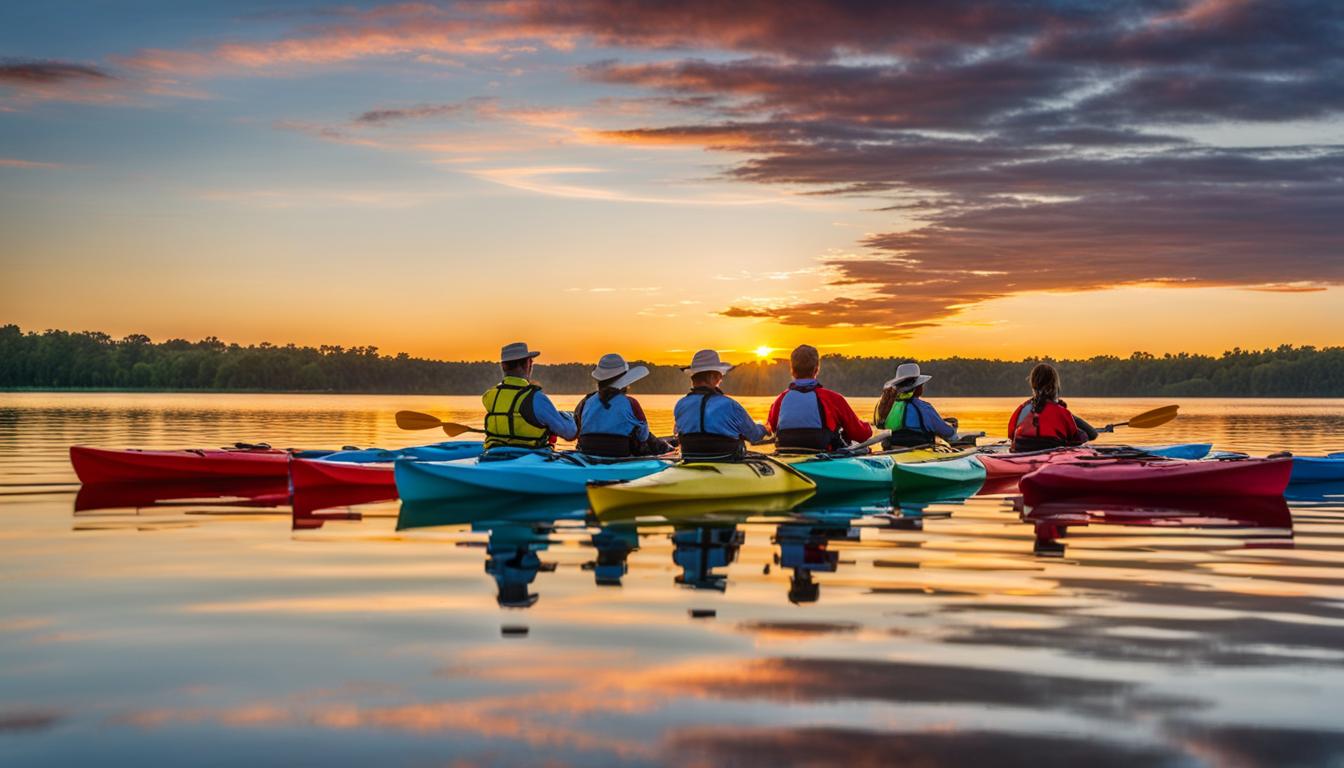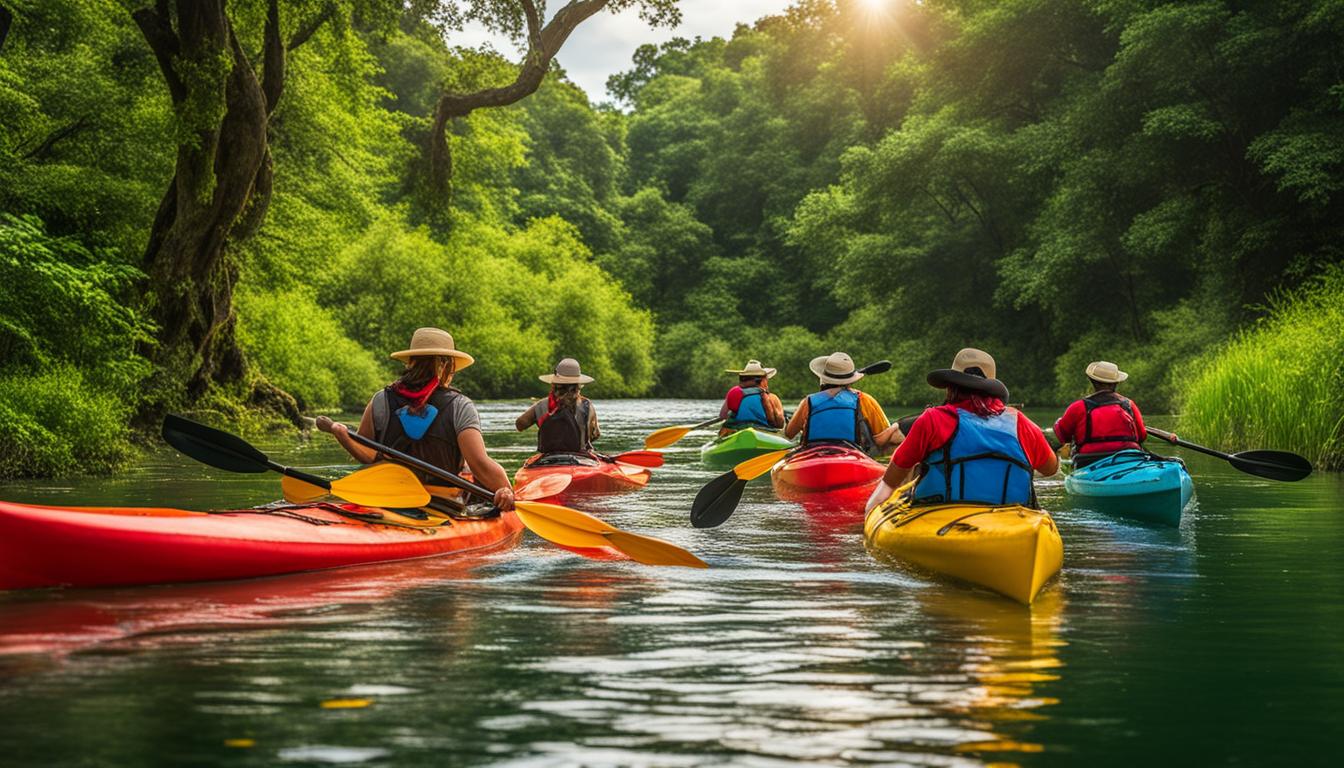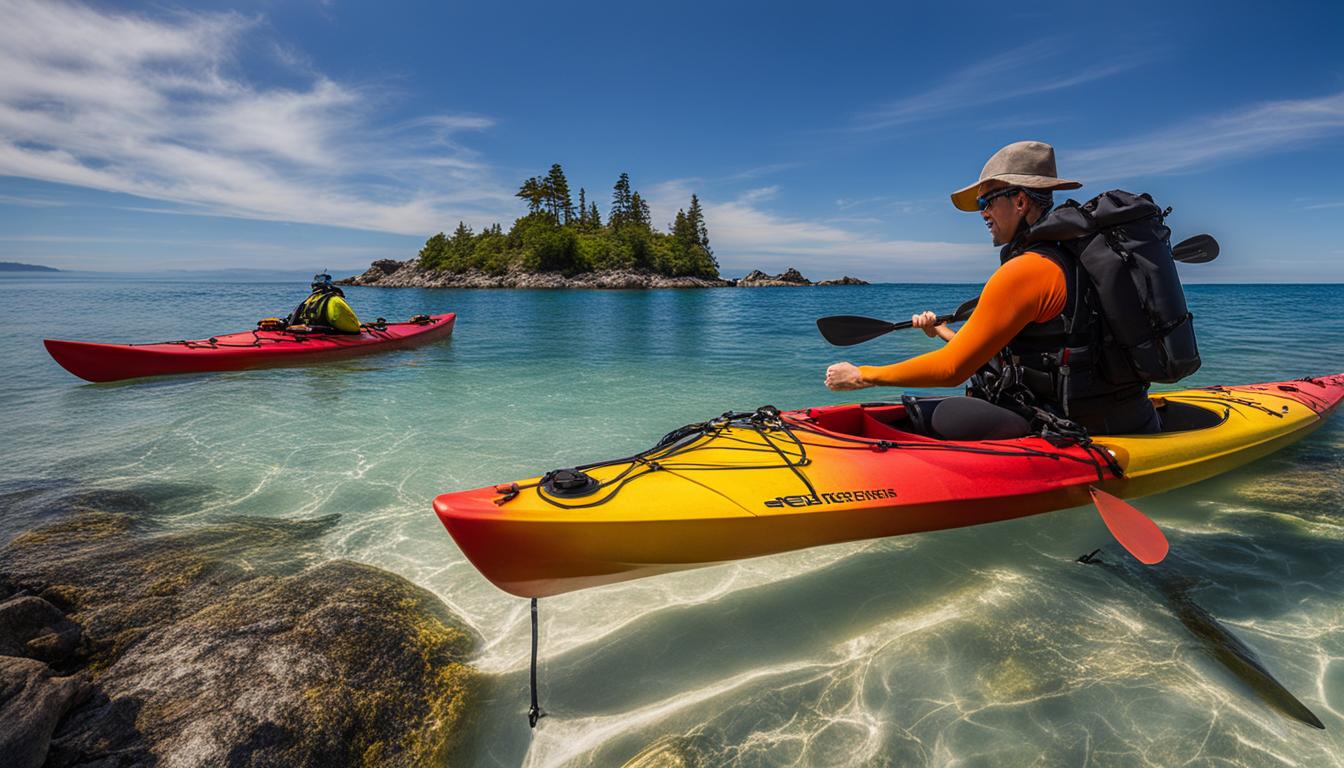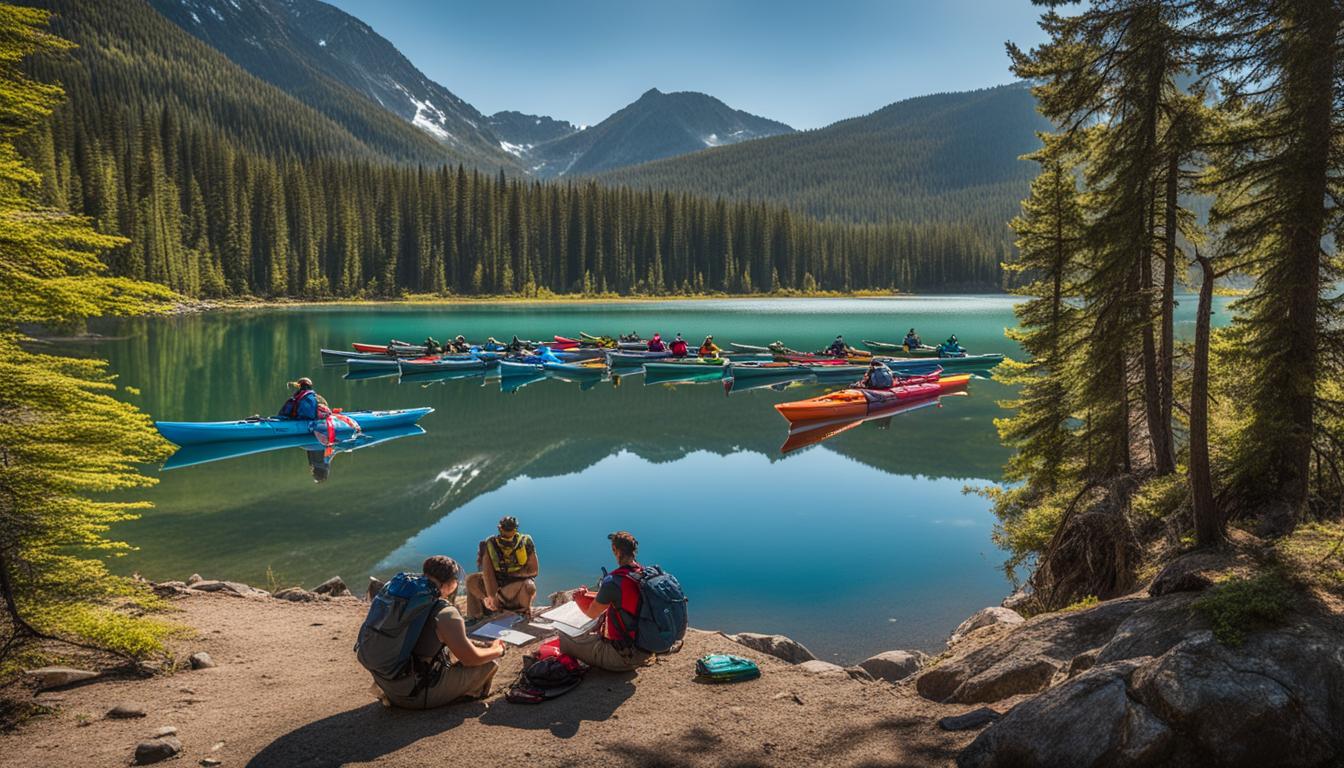When planning a kayak camping trip, it’s important to consider your cooking methods and the stoves you’ll need to prepare meals. The food and meals you prepare on overnight kayak trips are similar to what you might do on a hiking trip, but there are a few differences. It’s important to keep your kitchen gear and meals simple and pack light. You should also prioritize keeping your kitchen essentials and food dry by using sturdy Ziploc bags and dry bags. Don’t forget the importance of bringing along plenty of drinking water and a way to purify it for both hydration and kitchen cleanup. Now, let’s explore the different cooking methods and stoves suitable for kayak camping.
Key Takeaways:
- When planning a kayak camping trip, consider your cooking methods and the stoves you’ll need.
- Keep your kitchen gear and meals simple and pack light.
- Use sturdy Ziploc bags and dry bags to keep your kitchen essentials and food dry.
- Bring plenty of drinking water and a way to purify it for hydration and kitchen cleanup.
- Explore different cooking methods and stoves suitable for kayak camping.
Kayak Cooking Gear: Stove Options
When it comes to choosing a stove for your kayak camping adventures, there are several options to consider. Each type of stove has its advantages and disadvantages, so it’s important to weigh them before making a decision. Here are some popular stove options for kayak camping:
Wood-Burning Stoves
Wood-burning stoves are simple, lightweight, and easy to use as long as you have plenty of fuel. They provide a convenient way to cook meals while enjoying the natural surroundings. However, it’s important to note that starting a fire with wet or damp wood can be challenging. Additionally, wood-burning stoves require some time and effort to gather and prepare firewood. If you enjoy the process of building a fire and don’t mind the extra time it takes, a wood-burning stove can be a great choice for your kayak camping trips.
Canister Stoves
Canister stoves are another popular choice among kayak campers. They offer instant heat once lit, making them convenient for quickly cooking meals. Canister stoves are lightweight and portable, making them easy to carry in your kayak. However, it’s important to consider the cost of replacement fuel canisters, as they can be pricey. If you don’t mind the cost and value the convenience of instant heat, a canister stove may be the right option for you.
Liquid Fuel Stoves
Liquid fuel stoves are versatile and have refillable fuel canisters, making them a good option for frequent kayak campers. They can run on various types of liquid fuels, such as white gas or kerosene, providing flexibility in different environments and weather conditions. Liquid fuel stoves are known for their reliability and performance in extreme temperatures. However, they tend to be slightly bulkier and more complex to operate compared to other stove types.
Compact Camp Stoves
For kayaks with limited storage space, compact camp stoves are an excellent option. These stoves are designed to be lightweight and take up minimal space. They often work with denatured alcohol or solid fuel tablets, which are easy to pack and provide a reliable heat source. Compact camp stoves are ideal for solo kayak campers or those who prioritize space efficiency and simplicity. Although they may have slightly longer cooking times compared to other stove types, their compactness makes up for it.
When choosing a stove for your kayak camping adventures, consider factors such as weight, fuel availability, ease of use, and the specific needs of your trip. By selecting the right stove, you can ensure that cooking meals during your kayak trips is efficient, enjoyable, and fuel-efficient.
| Stove Type | Advantages | Disadvantages |
|---|---|---|
| Wood-Burning Stoves | Simple and lightweight | Requires ample fuel and time to start a fire |
| Canister Stoves | Instant heat, lightweight, and portable | Replacement fuel canisters can be expensive |
| Liquid Fuel Stoves | Versatile, refillable fuel canisters, reliable performance | Slightly bulkier and more complex to operate |
| Compact Camp Stoves | Lightweight, space-efficient, easy to pack | Longer cooking times compared to other stove types |
Table: Comparison of different stove options for kayak camping
Essential Kayak Camping Kitchen Gear
When it comes to kayaking camping trips, having the right kitchen gear can make all the difference in your cooking experience. Lightweight cooking equipment is essential for ensuring that you can easily pack and transport your gear without weighing down your kayak. Here are some top picks for compact and efficient cooking gear:
- Titanium Cookset: A titanium pot and pan set is lightweight and durable, making it perfect for kayak camping. Look for sets that include lids and foldable handles for easy storage.
- Long-handled Spoon: Having a long-handled spoon is crucial for reaching into deep bowls and pots without burning your fingers. Opt for a lightweight and sturdy spoon that can handle the rigors of kayaking.
- Multi-piece Cooking Set: Consider investing in a multi-piece cooking set that includes a colander, cutting board, and other essential kitchen tools. These sets often come with nesting pots and pans, making them compact and easy to store.
In addition to the cookware, you’ll also need some essential tools for food preparation and cleaning:
- Sharp Knife: A sharp, compact knife is a must-have for chopping fruits, vegetables, and other ingredients. Look for a folding knife with a secure locking mechanism for safety.
- Chopping Board: A compact and lightweight chopping board is essential for keeping your ingredients stable while cutting. Look for a folding or roll-up design that can be easily stored.
- Dishwashing Supplies: To clean your cookware and utensils, you’ll need biodegradable soap, a scrub brush or sponge, and a lightweight pack towel for drying. Opt for compact and eco-friendly options to minimize waste.
Having the right cooking gear will not only make meal preparation easier but also enhance your overall kayaking experience. By investing in lightweight and compact equipment, you can enjoy delicious meals without sacrificing space or convenience.
| Cookware | Pros | Cons |
|---|---|---|
| Titanium | – Lightweight and durable – Excellent heat distribution – Resistant to corrosion and scratches |
– Can be expensive – Not suitable for high-heat cooking |
| Aluminum | – Lightweight and affordable – Good heat conduction – Easy to clean |
– Prone to scratching – Not as durable as titanium |
| Stainless Steel | – Durable and long-lasting – Compatible with various heat sources – Easy to clean |
– Heavier than titanium and aluminum – Less efficient heat distribution |
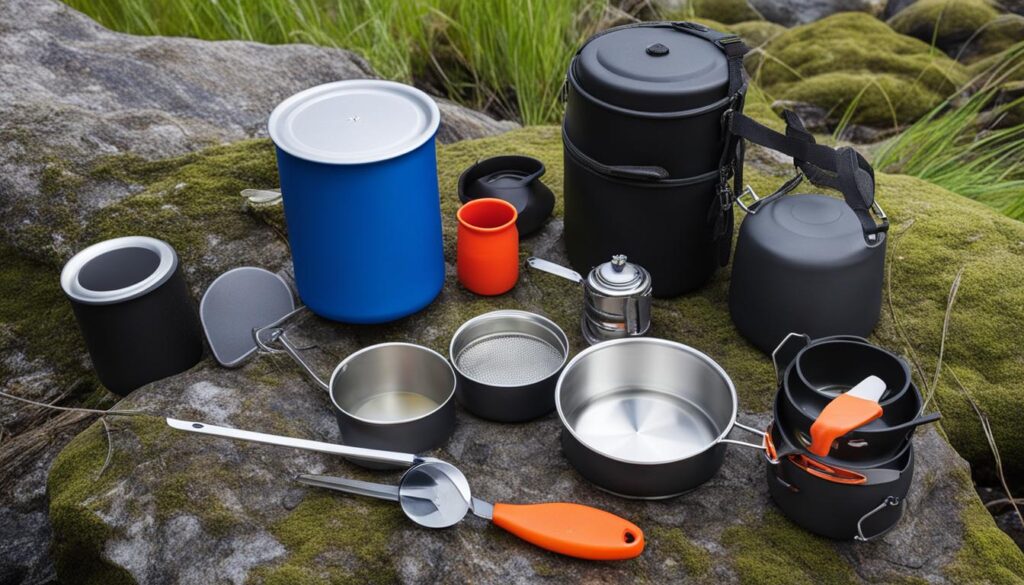
Choosing the Right Food for Kayak Camping
When planning your kayak camping trip, choosing the right food is essential for ensuring you have nourishing, delicious meals while navigating the waters. It’s important to select foods that are easy to pack, require minimal preparation, and provide a good balance of nutrients and energy. Here are some tips and ideas for selecting the perfect food options for your kayak camping adventure:
1. Pack Non-Perishable Foods:
Since you’ll be spending time in the great outdoors without access to refrigeration, it’s crucial to pack non-perishable food items. These include canned meats such as tuna or salmon, which can be added to pasta or enjoyed on their own. Pre-cooked rice, couscous, or quinoa are also great options as they only require hot water to rehydrate and are a good source of carbohydrates.
2. Choose Fast-Cooking Ingredients:
Since cooking space and time may be limited on a kayak camping trip, opt for ingredients that cook quickly. Instant oatmeal, which only needs hot water, is an excellent choice for a quick and easy breakfast. Pre-sliced hard cheese, beef jerky, and nut butter are great options for protein and healthy fats that don’t require cooking. Don’t forget to bring along instant rice or pasta, which can be cooked in just a few minutes on your chosen stove.
3. Consider Calorie-Dense Foods:
Kayak camping requires a lot of physical exertion, so it’s important to choose foods that are calorie-dense to keep you fueled throughout the day. Granola bars, trail mix, and dried fruits are all lightweight, compact options that provide a good amount of energy. Additionally, foods like pepperoni and cured meats are high in calories and can be added to meals for added flavor and sustenance.
4. Don’t Forget Hydration:
Staying hydrated is crucial on any outdoor adventure, including kayak camping. Remember to pack plenty of water and a portable water filtration system to ensure you have access to clean drinking water throughout your trip. You can also bring along powdered electrolyte mixes to replenish electrolytes lost through sweating.
By selecting the right foods and planning your meals ahead of time, you can enjoy delicious and satisfying meals while on your kayak camping adventure. Remember to pack foods that are easy to prepare, lightweight, and provide the necessary nutrients to keep you energized throughout your journey.
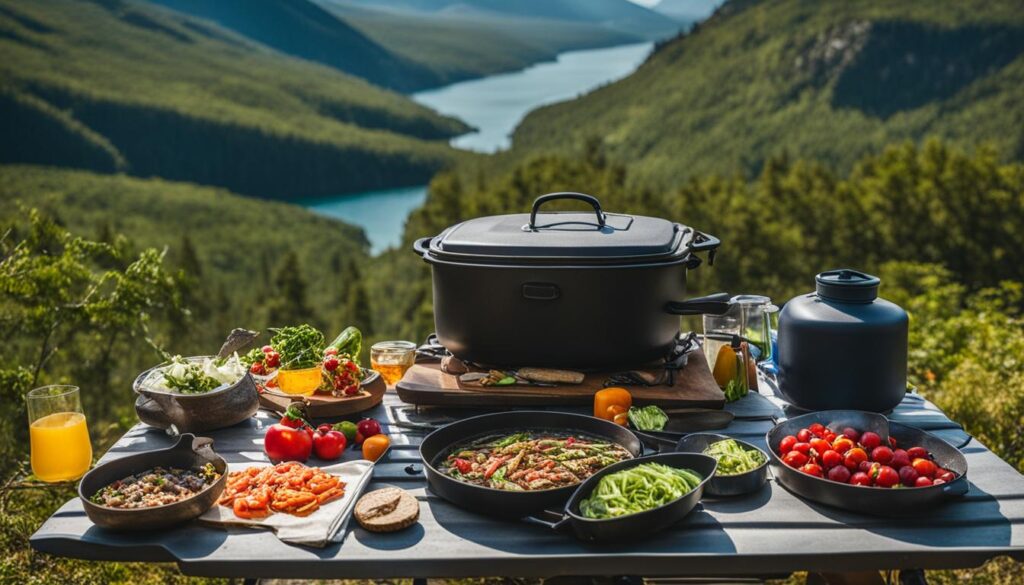
Conclusion
Choosing the right cooking methods and stoves for your kayak camping adventures is crucial for enjoying delicious meals in the wilderness. By keeping your kitchen gear and meals simple, ensuring they stay dry, and bringing along enough drinking water, you can enhance your kayaking cuisine skills. Consider the different stove options available, such as wood-burning stoves, canister stoves, liquid fuel stoves, and compact camp stoves, to find the one that suits your needs and preferences.
Additionally, ensure you have the essential kitchen gear, including a cookset, utensils, and dishwashing supplies. With the right cooking methods, stoves, and gear, you can savor hot meals while enjoying the beauty of nature on your kayak trips.
So, whether you prefer the simplicity of a wood-burning stove or the convenience of a canister stove, there is a perfect option out there for you. Embrace the joy of easy cooking on kayak trips and relish every bite of your flavorful meals. Happy kayaking and bon appétit!
FAQ
What cooking methods are suitable for kayak camping?
Wood-burning stoves, canister stoves, liquid fuel stoves, and compact camp stoves are all suitable for kayak camping.
Are wood-burning stoves easy to use for cooking meals?
Wood-burning stoves are simple to use as long as you have plenty of fuel, but they do require some time to start a fire.
What are the advantages of using canister stoves for kayak camping?
Canister stoves offer instant heat once lit, making them convenient for cooking meals while kayaking. However, replacement fuel canisters can be pricey.
Are liquid fuel stoves a good option for kayak camping?
Liquid fuel stoves are versatile and have refillable fuel canisters, making them a good choice for frequent kayak campers.
What are the best cooking gear options for kayak camping?
A basic cookset, utensils, a sharp knife, a chopping board, and dishwashing supplies are essential kitchen gear for kayak camping.
What kind of food should I pack for kayak camping?
Opt for simple ingredients that are easy to pack, non-perishable, fast-cooking, and calorie-dense. Consider pre-packaged meats, pre-cooked beans and grains, instant oatmeal, preserved meats, granola, pasta, instant rice, hard cheese, nut butter, beef jerky, and ramen.
How can I ensure my food and kitchen gear stay dry during a kayak camping trip?
Use sturdy Ziploc bags and dry bags to keep your kitchen essentials and food dry while kayaking.
What should I bring to purify drinking water during a kayak camping trip?
It’s important to bring along plenty of drinking water and a way to purify it, such as water purification tablets or a water filter, for both hydration and kitchen cleanup.


